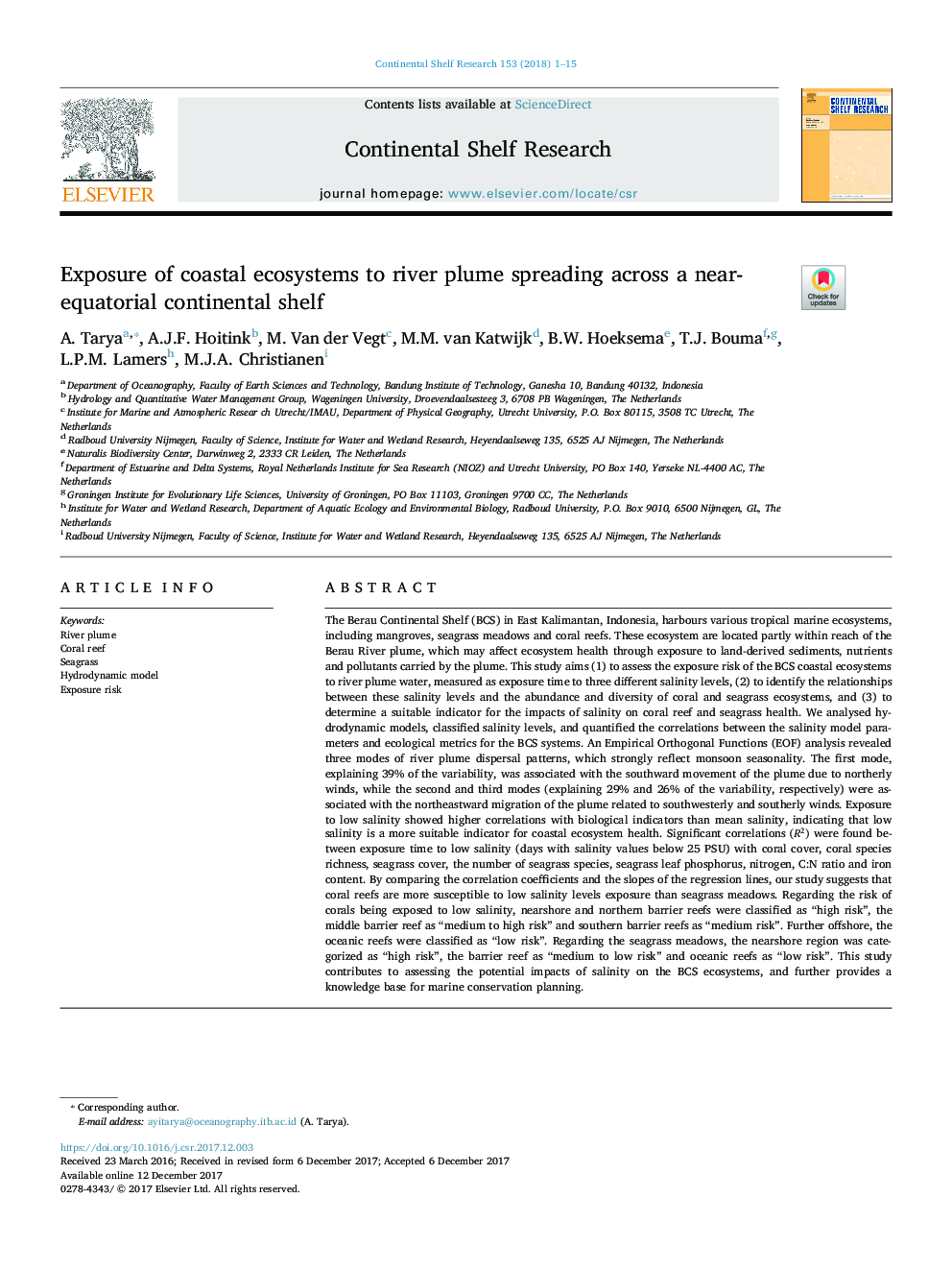| کد مقاله | کد نشریه | سال انتشار | مقاله انگلیسی | نسخه تمام متن |
|---|---|---|---|---|
| 8884096 | 1626060 | 2018 | 15 صفحه PDF | دانلود رایگان |
عنوان انگلیسی مقاله ISI
Exposure of coastal ecosystems to river plume spreading across a near-equatorial continental shelf
ترجمه فارسی عنوان
قرار گرفتن در معرض اکوسیستم های ساحلی به سواحل رودخانه گسترش یافته در یک قفسه قاره ای نزدیک
دانلود مقاله + سفارش ترجمه
دانلود مقاله ISI انگلیسی
رایگان برای ایرانیان
کلمات کلیدی
موضوعات مرتبط
مهندسی و علوم پایه
علوم زمین و سیارات
زمین شناسی
چکیده انگلیسی
The Berau Continental Shelf (BCS) in East Kalimantan, Indonesia, harbours various tropical marine ecosystems, including mangroves, seagrass meadows and coral reefs. These ecosystem are located partly within reach of the Berau River plume, which may affect ecosystem health through exposure to land-derived sediments, nutrients and pollutants carried by the plume. This study aims (1) to assess the exposure risk of the BCS coastal ecosystems to river plume water, measured as exposure time to three different salinity levels, (2) to identify the relationships between these salinity levels and the abundance and diversity of coral and seagrass ecosystems, and (3) to determine a suitable indicator for the impacts of salinity on coral reef and seagrass health. We analysed hydrodynamic models, classified salinity levels, and quantified the correlations between the salinity model parameters and ecological metrics for the BCS systems. An Empirical Orthogonal Functions (EOF) analysis revealed three modes of river plume dispersal patterns, which strongly reflect monsoon seasonality. The first mode, explaining 39% of the variability, was associated with the southward movement of the plume due to northerly winds, while the second and third modes (explaining 29% and 26% of the variability, respectively) were associated with the northeastward migration of the plume related to southwesterly and southerly winds. Exposure to low salinity showed higher correlations with biological indicators than mean salinity, indicating that low salinity is a more suitable indicator for coastal ecosystem health. Significant correlations (R2) were found between exposure time to low salinity (days with salinity values below 25 PSU) with coral cover, coral species richness, seagrass cover, the number of seagrass species, seagrass leaf phosphorus, nitrogen, C:N ratio and iron content. By comparing the correlation coefficients and the slopes of the regression lines, our study suggests that coral reefs are more susceptible to low salinity levels exposure than seagrass meadows. Regarding the risk of corals being exposed to low salinity, nearshore and northern barrier reefs were classified as “high risk”, the middle barrier reef as “medium to high risk” and southern barrier reefs as “medium risk”. Further offshore, the oceanic reefs were classified as “low risk”. Regarding the seagrass meadows, the nearshore region was categorized as “high risk”, the barrier reef as “medium to low risk” and oceanic reefs as “low risk”. This study contributes to assessing the potential impacts of salinity on the BCS ecosystems, and further provides a knowledge base for marine conservation planning.
ناشر
Database: Elsevier - ScienceDirect (ساینس دایرکت)
Journal: Continental Shelf Research - Volume 153, 1 February 2018, Pages 1-15
Journal: Continental Shelf Research - Volume 153, 1 February 2018, Pages 1-15
نویسندگان
A. Tarya, A.J.F. Hoitink, M. Van der Vegt, M.M. van Katwijk, B.W. Hoeksema, T.J. Bouma, L.P.M. Lamers, M.J.A. Christianen,
